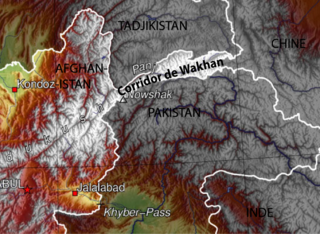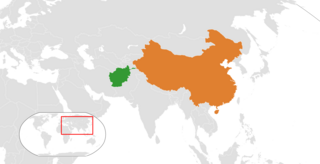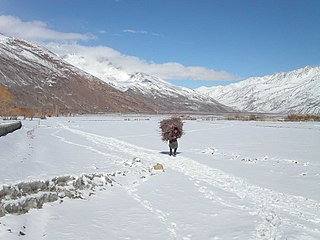
The Wakhan Corridor is a narrow strip of territory in Badakhshan Province of Afghanistan, extending to Xinjiang in China and separating the Gorno-Badakhshan Autonomous Region of Tajikistan in the north from the northern areas of Pakistan in the south. From this high mountain valley the Panj and Pamir rivers emerge and form the bigger Amu River. A trade route through the valley has been used by travellers going to and from East, South and Central Asia since antiquity.

Wakhi is an Indo-European language in the Eastern Iranian branch of the language family spoken today in Wakhan District, Northern Afghanistan and also in Tajikistan, Northern Pakistan and China.

Badakhshan Province is one of the 34 provinces of Afghanistan, located in the northeastern part of the country. It is bordered by Tajikistan's Gorno-Badakhshan in the north and the Pakistani regions of Lower and Upper Chitral and Gilgit-Baltistan in the southeast. It also has a 91-kilometer (57-mile) border with China in the east.
Ab Gaj is a village in Badakhshan Province in north-eastern Afghanistan. It is on the left bank of the Ab-i-Wakhan about a mile upstream of the meeting of that river and the Amu Darya, and about ten miles southeast of Kala Panja.
Deh Gholaman is a village in Badakhshan Province in north-eastern Afghanistan on the Wakhan River, roughly 20 miles west of Baroghil.

Ishkashim is a border town in Badakhshan Province of Afghanistan. With a population of around 12,120 people, the town serves as the capital of Ishkashim District. Another town by the same name is located on the other side of the Panj River in the Gorno-Badakhshan region of Tajikistan, although that town is normally transliterated Ishkoshim following Tajik practice. A bridge linking the two towns was reconstructed in 2006.
Gaz Khan or Goz Khun is a village in the Wakhan in Badakhshan Province in north-eastern Afghanistan. It is located at the confluence of the Panj River and Wakhan River, The village is the starting point for treks into the Great Pamir.
Kashkandyow is a village in Wakhan District, Badakhshan Province in north-eastern Afghanistan.
Khandud (Khandut) is a village in Badakhshan Province in north-eastern Afghanistan. It is in Wakhan District, near the left bank of the Panj River.
Langar is a village in the Wakhan District of Badakhshan Province, in north-eastern Afghanistan. It lies on the river Panj, opposite the larger village of Toqakhona in Tajikistan.
Patukh is a village in the Wakhan, Badakhshan Province in north-eastern Afghanistan. Patukh is inhabited by Wakhi people. The population of the village (2003) is 405.
Qalʽeh-ye Panjeh, also written Qila-e Panjeh and Kala Panja, is a village in Wakhan, Badakhshan Province in north-eastern Afghanistan. It lies on the Panj River, near the confluence of the Wakhan River and the Pamir River.
Qazi Deh is a village in Badakhshan Province in north-eastern Afghanistan. It lies on the left bank of the Panj River, 20 km from Ishkashim.

Sarhadd or Sarhad, also known as Sarhad-e Broghil or Sarhad-e Wakhan, is a village in the Wakhan District of Badakhshan Province, Afghanistan.

The Wakhjir Pass, also spelled Vakhjir Pass, is a mountain pass in the Hindu Kush or Pamirs at the eastern end of the Wakhan Corridor, the only potentially navigable pass between Afghanistan and China in the modern era. It links Wakhan in Afghanistan with the Tashkurgan Tajik Autonomous County in Xinjiang, China, at an altitude of 4,923 metres (16,152 ft), but the pass is not an official border crossing point. With a difference of 3.5 hours, the Afghanistan–China border has the sharpest official change of clocks of any international frontier. China refers to the pass as South Wakhjir Pass, as there is a northern pass on the Chinese side.

The Little Pamir is a broad U-shaped grassy valley or pamir in the eastern part of the Wakhan in north-eastern Afghanistan. The valley is 100 km long and 10 km wide, and is bounded to the north by the Nicholas Range, a subrange of the Pamir Mountains.
There are several hundred Kyrgyz in Pakistan, most of whom are immigrants based in the northern areas of the country. They have historically inhabited the Gojal valley of Gilgit-Baltistan. Pakistan's Broghil Pass, situated between Chitral and the Wakhan Corridor, also once had a large resident Kyrgyz community. Some hail from the town of Uzgen in the west of Kyrgyzstan; in addition, many were previously settled in the Little Pamir valley of the Wakhan corridor in Afghanistan. They fled to Pakistan in the aftermath of the Afghan Saur Revolution, leaving much of their wealth and animal herds behind.

The Afghanistan–China border is a 92-kilometre-long (57 mi) boundary between Afghanistan and China, beginning at the tripoint of both countries with the Pakistan's federally administered territory of Gilgit-Baltistan, following the watershed along the Mustagh Range, and ending at the tripoint with Tajikistan. This short border is in the far northeast of Afghanistan, distant from much of the country or urban areas in either country, at the end of the long, narrow Wakhan Corridor. The Chinese side of the border is in the Chalachigu Valley. The border is crossed by several mountain passes, including Wakhjir Pass in the south and Tegermansu Pass in the north.
Karachukar Valley or Chalachigu Valley is a valley in Taxkorgan Tajik Autonomous County, Xinjiang, China. It contains the basin of the Karachukar River, a tributary of the Tashkurgan River, and is regarded as part of Taghdumbash Pamir. The valley borders Afghanistan to the west and northwest, Tajikistan to the north, and Pakistan to the south. The name of the valley is from Kyrgyz, meaning "black cave".










